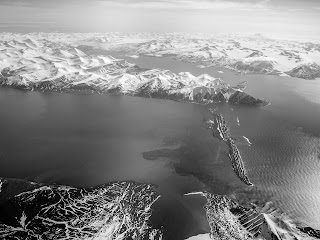Hello everyone, it's Holger again!
A little later than originally anticipated, but here it is: as promised I want to talk about the trip to Barentsburg Matt and I did with the environmental management course and our meeting with the Russian Consul General. And then I'll talk a little more about other stuff we have been up to :-)
We all got snowmobiles from UNIS to drive to Barentsburg, which is about 2 hours drive away. The visibility was quite poor unfortunatelly, so we couldn't really see much of the landscape on the way. However, we arrived at Barentsburg Hotel in the early evening. A local guide showed us the mining town, it's not pretty but very fascinating. Many houses were abandoned and lay in ruines, a few have been renovated for the local population though. There are also still a lot of traces from the Soviet era such as a Lenin bust in the middle of town. In combination with the coal mining activities the whole place had certainly a "Russian feeling" to it. After the little tour around town we had a look in the museum. It was really small but they had a lot of stuffed animals and information about the history of the Russians on Svalbard and in Barentsburg in particular, which was nice. They also had the heart of a polar bear in a jar, it's as large as a childs head, absolutely massive! We spend the rest of the night in the hotel, having a few beers at the bar and playing cards. Our meeting with the Russians was sceduled for 10 to 11am the next morning. The meeting was very interesting. Everyone was really friendly and it felt pretty official, they even had a translator. First they introduced themselfs and the city to us and then we had about 45 minutes to ask questions. My favourite was "In the light of climate change, do you consider using more green energy in the future instead of coal?" The Consul General was obviously confused and just said: "Why should we? There is plenty of coal left..."
After the meeting we took the obligatory picture of the class with the consul and the translator. I think they take the same picture every year.
The way into Barentsburg, minig ain't pretty...
Some cow barns, they actually keep livestock here.
And of course comrade Lenin!
The local orthodox church at dusk
AB-203 class with the Russian Consul General (photo credits: Børge Damsgård)
The next and last excursion we did with the Environmental Management course was to SvalSat, a comercial ground station for polar orbiting satellites. They do a lot of stuff for NASA and ESA, but also work for weather forcast and so on. We didn't spend that much time there, and Matt and I have already been there with the Northern Lights course in February. They gave us the same lecture as they did then, but this time inside of one of the big satellite dish thingies. The first time I ever had a lecture at -15C, but they provided us with reindeer furs and blankets. On our way home we saw a polar fox, the first I've ever seen! :-)
A one hour lecture under the satellite dish at -15C is not an everyday thing
That's the same from the outside
The last experience I want to share with you for this time is from the trappers trail 2 weeks ago. Trappers trail is a big dog sled race from Longyearbyen to Kapp Laila over 2 days. It's also the worlds northernmost dog sled race! I volunteered myself and my snowmobile to help out, my job on the first day was to put up warning signs whereever the race track crossed main snowscooter tracks or when the terrain was narrow without space to give way to potential traffic. I also had to put up tents at Kapp Laila, take the times for the first day and prepare a small cabin. So lots of work to do, and all I got was a t-shirt. Not that I'm complaining, it's a cool t-shirt :-) It was very windy and snowing on Saturday, which made the actuall driving very difficult. We couldn't go faster than 30km/h due to whiteout, but I had to carry a heavy sledge, so that was probably good for the engine of my little 2-stroke scooter anyway.
Well, whatever, after I did all the tasks I had to do, a few other volunteers and I had some time for a nice BBQ and for the general joys of camping in the Arctic. We saw some belugas in the bay, and allegedly there were orcas as well, which I didn't see unfortunatelly. On Sunday I had to make sure all participants were leaving on time, and generally help out. After everyone else was gone we had to clean the cabin, and follow the race track home, to make sure everybody got home. All in all a very interesting experience, and the doggies are of course super cute :-) I also had a chance to chat with Christine, who was also helping with the race. For those of you who don't know her, she was a student at SAMS a couple of years ago, and now she is living on Svalbard.
One cannot just leave Svalbard, it is the call of the Arctic...
The participants are getting ready infront of the UNIS building in Longyearbyen
Our camp at Kapp Laila. The cabin was really nice but for participants and organiser only...



















































